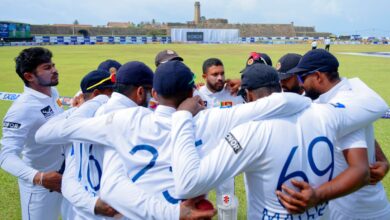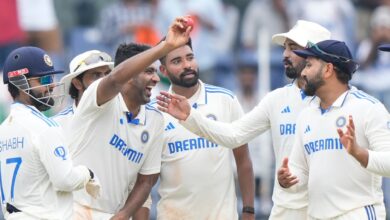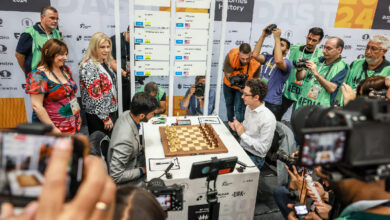Paralympians Avani Lekhara and Sumit Antil at Idea exchange: ‘People used to think she sits and shoots… might be easier for her’ | Sport-others News
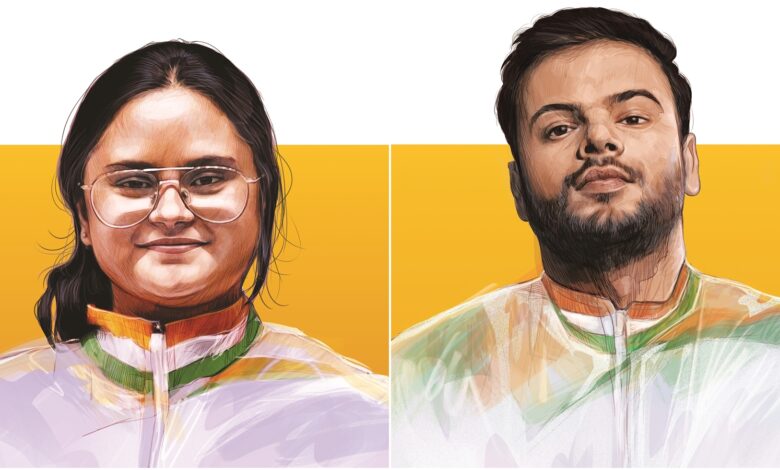
Paralympic champions air rifle shooter Avani Lekhara and javelin thrower Sumit Antil are hugely inspirational high achievers for persons with disabilities. They speak about overcoming their physical and mental challenges, inspiring people and bridging the comparison gap. The conversations were moderated by Assistant Editor Nitin Sharma.
Nitin Sharma: Going into the Paris Paralympics, was there any extra pressure on you, being the defending champion?
Yes, definitely. When you go there for the first time, you just go to gain experience. But when you go as the defending champion, everyone has expectations from you. You yourself also have a lot of expectations. But that can also hamper your mental state at some point. I am glad that I could defend my title.
Nitin Sharma: You also had to deal with gallbladder stones surgery months prior to Paris. Can you talk us through that phase?
It had been hampering me for a long time. In January, it got worse and doctors advised me to undergo the gallbladder removal and I underwent surgery in April. I shoot in a wheelchair and my core strength and core muscles play an important part for me. I was advised complete bed rest for one month. Everyone was training and competing and I was sitting at home and doing nothing. It was not good for my mental health either. I was thinking why has this happened just before the Paralympics.

Mihir Vasavda: Has sport been a tool for empowerment for the differently abled?
Definitely. Sport has given me a lot, in terms of medals and all. But the self confidence I get when I go outside, when I represent a community… Multiple times, people have come up to me and said, ‘you’ve inspired me a lot’, ‘because of you, we also don’t want to give up in our lives’. Listening to that feels like a bigger success to me. When you are at that platform, you also want to be the best example and spread the awareness about inclusivity in India and how it should be.
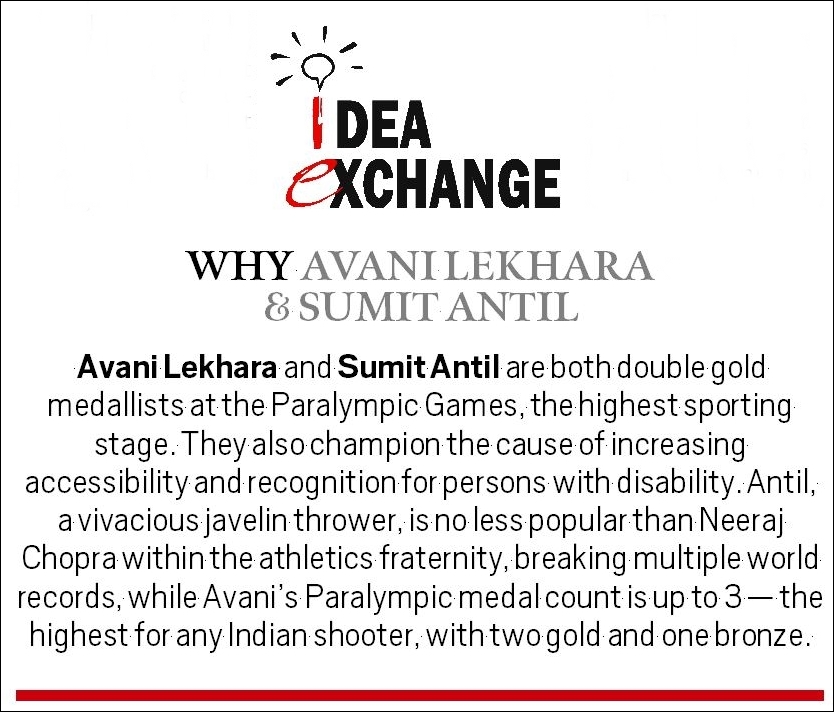
Nitin Sharma: You also compete in the 50m Rifle 3P event and the mixed events. 3P is an endurance event. How do you prepare for these events mentally as well as physically?
Well, it’s very tough. Especially, now we have 120 shots in qualification in Paralympics as compared to 60 shots in Olympics. And in the final, one has to shoot 45 shots. In 10m standing, your core strength is so important. In 50m standing, everything is doubled because the rifle weight increases. I started with the 3P event very late prior to Paris due to the surgery. I am happy that I was able to be in the finals and come fifth.
Shivani Naik: Was there a particularly bad phase in life, having to deal with disability? How did sport help?
Sport has the power to change perception — of how people see you, look at you. A lot of people who used to earlier look at my wheelchair first, started seeing me as a person.
Initially, when I met with the accident I didn’t know how life would change. If I’ll be able to do anything in life or not, in a wheelchair. When I started sports, I started meeting new people, going to new places, representing my country. It kind of changed my perception too. It made me feel if others can do it why can’t I? There are so many people with severe disabilities who are living their life better than me. That inspired me to go and do my best. That’s how sport changes you. I see many people with disabilities who want to live their life just as normal as possible. And how they’ve made changes in their life and routine.
Mihir Vasavda: There are people who say Paralympians aren’t funded the same way as Olympians and there are others who say enough is being done. What is your take?
The government has been super supportive. They have always been there for me, be it equipment, training facilities, coaching. I am happy with the things I have got. I think the whole scenario for me is how I wanted it.
Nitin Sharma: Shooting is as technical a sport. But did you have to face things like people downplaying the achievement or any bias in your initial years?
Initially, yes definitely. People used to think that she is sitting and shooting, so it might be easier for her. She does not feel pain in her legs or she does not have to stand for a long time.
But then people started realising the effort. It’s all about awareness and education. When it starts happening on a large scale, people also understand that my core is kind of working like my legs and I also put in an equal amount of hard work and I also get equally exhausted when I do long training. I have started seeing a lot of changes because people now know about Paralympics.
Shivani Naik: Does it get boring to constantly focus on one dot to attain perfection? How do you unwind, take your mind off shooting?
No, it’s not at all boring. Only a shooter knows how it feels. That one dot, the centre point, even a dead target, can give you so many emotions that you never thought you could feel. It’s too much sometimes. You compete with yourself. So it gets difficult sometimes.
There are days when you do practise, but the match doesn’t go how you want it to go. But now that I’m mature, I don’t take it to heart. I tell myself it was not my day. It’s OK. There can always be a tomorrow. That’s how I take it. I try to do a lot of mental training, yoga, etc. to help me unwind.
Mihir Vasavda: In terms of accessibility at shooting ranges across the country, have you noticed any changes? Or are there any challenges you continue facing?
The government facilities are quite accessible, especially the Karni Singh Shooting Range, the Bhopal Shooting Range. But the private ranges, even the normal infrastructure outside, the public transport… if you want to travel alone, it’s very difficult for a person (with disability) to travel alone in India. There’s a lot of need for accessible (infrastructure).
Even going to general stores to get household things not just for me but for any person with a disability. The roads, too. In the rainy season, it’s difficult for a person in a wheelchair to move properly and travel alone. For that, it’s a long way to go and we have not even started.
Nitin Sharma: How do you see each of the Paris medallists helping other para athletes? And also the society becoming more inclusive… What more needs to be done?
I think, yes, definitely, you know people seeing Paralympians and their inspiring stories is definitely inspiring and it’s definitely changing the mindset of people. There are many who come in between this spectrum, who are normal people with some disability and living their lives.
They don’t even want to do sports. They just want to live as normally as possible and they want that inclusivity and accessibility around and that only comes once people know and learn about how it goes.
*****
Excerpts from the conversation with Sumit Antil:
Nihal Koshie: The prosthetic is worn on your blocking leg (left) which is crucial in javelin. What are the challenges?
The biggest issue is balance. I tend to go towards the left. There is a problem with the alignment. The blocking leg is artificial so there is no feeling. I don’t get the balance that a normal leg has. Then there is stump pain and cuts (on the stump), but I am used to that now.
Mihir Vasavda: What issues of food and track did you face in Paris?
The mental pressure was so much that it didn’t strike me that I could order food from outside (the Village). So I ate whatever I got there. I lost a bit of strength during those 10 days. They’d made a speed track this time. I am a power thrower. We can’t generate so much speed with an artificial limb. I would reach the throwing line soon after I started my run up.
Mihir Vasavda: Are medals more important or world records?
Both. Before I started the game in December 2017, I was researching which game would interest me. I hadn’t selected javelin then but I liked the sport, watching senior athletes. After that, I asked one of the senior throwers, ‘bhaisaab, iska world record kitna hai?’ They would laugh. I hadn’t even played anywhere, didn’t even know how to hold a javelin and I was talking about a world record. But from the beginning, my main goal was to set a world record. The gold would follow.
Nitin Sharma: Tell us about your first competition in 2018, at Finland?
I had arranged funds for the trip through my road accident insurance and some from my mother. SP Sangwan sir from PCI (Paralympic Committee of India) also helped. I sat in a flight for the first time and went to Kuortane in Finland and saw Neeraj bhai for the first time. I had heard about him earlier but had never met him. The way he met me and encouraged me that I have a good physique and I would do well in future was the biggest positive for me from that trip.
Nitin Sharma: Tell us about the camaraderie with Neeraj Chopra.
He is also a world class athlete and it’s not like we converse daily. But we do talk once in a fortnight. Before I competed in Paris Paralympics, he had met one of my team members and conveyed to me that the Mondo track is soft and that I should not try anything new. He also motivates me to chase the 75metre or 80 m mark.
Sandeep Dwivedi: What’s with Indians and javelin throws? Some say, due to cricket, north Indians have stronger upper bodies.
I don’t think that cricket has any role in this. I have never bowled ever though I have played cricket. But genetics surely plays a role. I was a wrestler for more than eight years and was training for the Army before my accident. So I had the strength as any elite athlete and worked on my technique. Yes, one needs upper body strength in an event like javelin throw and youth from Haryana, Punjab, Delhi, Uttar Pradesh have good upper-body strength.
Sandeep Dwivedi: What’s your advice to anyone who faces a mishap like yours?
I have seen many who have fallen into drugs or have gone astray. They think they are a burden to their families. I would say, whatever is left, try to give your best and achieve the best and support will come. The government is also promoting para sports in a big way and there will come a time when one can see himself in the mirror and tell his inner self that he has done justice to his life.
Nitin Sharma: What were your initial struggles with the prosthetic leg and adjustments you had to make?
When I started, there was this socket which I had to strap on my knee and it cost about one lakh at that time. My initial thought was whether I would be able to justify the cost? But then my mother got it made so that my knee would not bleed. When I started training, I was close to the world mark in less than six months. And there were times, when I would get the new prosthetic worth Rs 3-4 lakh and it would break the same day. But then the Artificial Limb Centre in Pune would get me a new one every time the old one broke. The wounds still happen sometimes, but then I am reminded of my target. Sometimes, the body also gives up after ten days of hard training but then it’s the target of touching the 80m mark which pushes me.
Nitin Sharma: Can you take us through the day of your bike accident. You spent 53 days at the Base Hospital.
It was January 5, 2015. I had not driven a motorbike on the highway before. A tractor coming from behind, hit us and we were dragged along the road. I immediately realised that my leg will either be amputated or be of no use. The first thought which came in my mind was that I cannot join the Indian Army now nor can I become a wrestler. Later, the doctors at Base Hospital in Delhi told me that they have to amputate my leg. If it was in the same condition, it would have been of no use and would have created hurdles.
Nitin Sharma: Is Indian society inclusive towards para athletes?
A lot of work needs to be done. There has been a thought that competition is less in Para competitions. After winning Tokyo, people would tell me that your throw is 68m and Neeraj throws more than 87m. Nobody was seeing that I threw with one artificial leg. There were comparisons of metres. But then I tell them that I will try my best. And I hope this comparison gap is bridged.
Mihir Vasavda: What do you look at while watching Arshad Nadeem? He appears so casual while others labour over throws.
We feel that he is throwing easily but it is years of hard work. Balance plays a very important role in javelin throw and his body balance is because of raw talent. I would like to congratulate him for winning a gold medal for Pakistan. But I feel, he lacks consistency. Neeraj bhai has been in the 85m to 90m range since 2016. You take all the stats and it’ll be tough to find an athlete who is so consistent. Even Jan Železný may not have been so consistent.
Sriram Veera: How challenging was life after the accident?
When this kind of accident happens, people start looking at you differently; they start showing sympathy. What stings you the most is sympathy. Frustration starts growing inside. There are only two options then: either you are completely cut-off from the world or you try to make yourself a better person. People who try to better themselves end up achieving something big. My mother never made me feel like a bechara. Rather she would say, go work in the khet (fields). She would scold me even more! (Laughs), saying ‘you are normal, nothing big has happened, just a wound, go out!’



